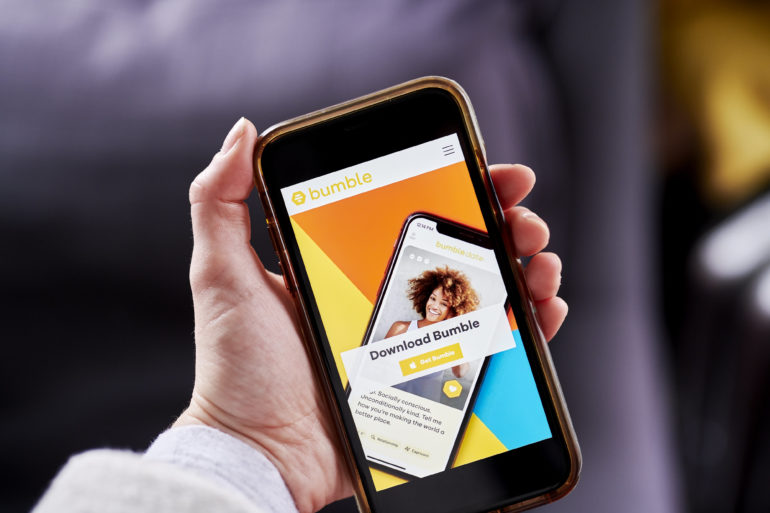Dating apps have been operating on the same model for years: Users throw in a handful of pictures and fill out a bio. For the most part, people look at those profiles and swipe left to deny, or right to express interest. If two people swipe right, they match and could end up on a date.
But now that’s changing.
The pandemic has caused a level of disruption that’s allowed companies to consider what the future of dating apps without mindless swiping might look like.
Look to Bumble, for example, which has a “Night In” trivia option. The feature lets users set up a virtual trivia date if they match with someone. It also allows users to send matches voice memos, a feature that went viral on TikTok earlier this year.
And Tinder, Match Group’s largest dating app, has “Swipe Night,” a live, interactive dating feature where singles follow a storyline together. During a set period of time, people try to figure out who committed the made-up crime. At the end of each episode, members work with another participant through “Fast Chat,” where they’ll be able to talk about the story, analyze different clues, and help solve the mystery together. They can also later choose to match.
The addition of videos and audio will let people interact in a way that hasn’t been done yet with online dating, with the hopes they’ll spend more time on the apps (bringing in more money) and form better connections that could draw more people online.
The companies have hinted that there’s more to come in terms of social elements and more interactive features, but haven’t said exactly what’s on their product roadmaps. Potential features could include a Clubhouse-like audio chat or more ways to integrate friends into the experience.
“While swiping left and right has meaningfully changed how singles connect, we think users want more control over that experience,” Citi senior analyst Nicholas Jones told CNBC in an email. “To maintain a healthy and engaged network, BMBL will need to continue to innovate to provide users the experience they are looking for.”
Users have made it clear they’re interested in meeting up over video as a way to break the ice or check a date’s “vibes” before seeing them in person. Tinder said that nearly of users had a video chat with a match during the pandemic, while 40% planned to continue using video even when the pandemic is over.
Singles know what they’re looking for
Bumble said that coming out of the pandemic, people are “much clearer” with what they’re looking for from a relationship.
“We are really trying to give them the tools to do that and make the experience better for the more serious and intentional types of relationships that our users are talking about,” Bumble President Tariq Shaukat said on the company’s most recent earnings call. “So, a lot of what we’ve done in Q2 as well as the plan for Q3 and Q4 is really focused on activities like that in addition to new monetization features.”
Bumble, as mentioned, has Night In and the option to send things like pictures, voice notes and GIFs to matches. But the company could introduce things like video to users’ profiles or new ways to discover users outside of swiping right and left.
Tinder said the changes are an effort to give Gen Z users what they want.
“Gen Z is using Tinder on their terms; bios alone don’t always tell enough of the story to get to a Like or a Nope,” the company said in June. Tinder is focused on the moment when someone is ready to swipe left or right on another user, CEO Jim Lanzone later explained to CNBC.
“That’s a really rich area for innovation,” he said. “This is the beginning of something.”
Lanzone joined Tinder last year after leading CBS Interactive, where he developed the company’s push into streaming. The executive’s hire was a clear indication Tinder wants to push more into video. But this time, he said, the focus is on making connections, not entertainment.
“Tinder itself is likely the number one generator of new relationships in the country, and probably marriages as well, on top of all the other connections that we make. And that’s not always something you can decide on the fly from just from someone’s photo or bio, though those are important, and Tinder, obviously, was a pioneer in moving category that way,” Lanzone added. “But we have this really rich roadmap now of, years probably, of innovation.”
Tinder’s parent company is also making broader moves. Earlier this summer, Match closed its $1.7 billion acquisition of Hyperconnect, a social networking company that’s credited with building “the first mobile version” of WebRTC. That will allow the company to focus on its research & development, adding more live chat features and video experiences to its apps.
Match COO Gary Swidler said on the company’s most recent earnings call that it expects at least two of its brands to use Hyperconnect tech before the end of the year, while a number of other brands will implement its tech by the end of 2022. The company hasn’t detailed exactly what the additions would look like, but it could include things like live broadcast or even more chat additions.



